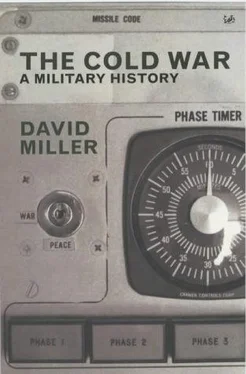The International Military Staff (IMS) was also large, with tentacles spread throughout the Alliance, most of its tasks being to make plans for war, to provide co-ordination on military matters, and to service a multitude of international committees and working groups. These were the forums at which national representatives provided the views of their defence ministries to NATO and took back the views of the committee or working group to their capitals. The committees and working groups covered a vast range of subjects, ranging from weapons standardization, through data systems inter-operability, to the specifications for the fuel to be used in military aircraft.
NATO also had a variety of executive functions. At NATO Headquarters itself, the IMS divisions covered intelligence; plans and policy; operations; logistics and resources; communications and information systems; and armaments and standardization. There were also a number of bodies responsible for the management of NATO-owned systems, such as the NATO Airborne Early Warning Programme Management Agency (NAPMA), which managed the NATO airborne-early-warning force of E-3A Sentry aircraft at Geilenkirchen in West Germany, the Central European Pipeline Office (CEPO), which managed NATO’s fuel pipeline and storage system, and the NATO Communications and Information Systems Agency (NACISA).
NATO owned and operated several training centres, which included the NATO Defence College in Rome, the Supreme Headquarters Allied Powers Europe (SHAPE) Training Centre at Oberammergau in West Germany, the Long-Range Reconnaissance Patrol School in southern Germany, and the NATO Communication and Information Systems Training Centre at Latina, in Italy. Research facilities included the SACLANT Undersea Research Centre at La Spezia, Italy, and the SHAPE Technical Centre, which provided scientific and technical advice and support to SHAPE from its base in The Hague.
IN SUCH A vast organization which endured over such a long period and was composed of such disparate nations, most of whom had fought each other at least once in the twentieth century, there were inevitably a number of stresses and strains. Never once, however, did they lead to a member leaving the Alliance, either of its own volition or as a result of expulsion.
The most critical of these strains involved France’s departure from the integrated command structure. The reasons for this were grounded in recent French history. France had been totally humiliated by the rapidity with which the German forces overran the country in 1940. These problems were exacerbated by the split between the Vichy government, headed by Marshal Philippe Pétain, and the Free French, headed by General Charles De Gaulle. Although the latter participated in the Allied successes in 1944–5, it was always as a junior partner to the USA and the UK; but in the final days of the war De Gaulle’s personality was so strong that he managed to secure a French zone of occupation both in western Germany and in Berlin.
Following De Gaulle’s resignation as president in January 1946, France suffered from a succession of governments in the late 1940s, from a substantial degree of antipathy between former Vichyists and those who had served in either the Free French forces or the resistance, and from a powerful Communist party. Despite these problems, the French rebuilt their armed forces rapidly (with substantial aid from the USA and, to a lesser extent, from the UK), and they also reimposed control over their colonial empire.
The French quickly appreciated that, if their country was to regain its position as a Great Power, it had to possess its own atomic-energy programme. The British had come to the same conclusion, but France was in an infinitely worse industrial position than the UK and, unlike the British, its scientists had not been involved in the United States’ Manhattan Project during the war. Nevertheless, the Commissariat à l’Énergie Atomique (CEA) was established as early as October 1945 and, in an essentially civil programme, the first nuclear reactor went critical in December 1948.
The French military monitored CEA’s progress, but it was not until the early 1950s that they began to take a serious interest in building a bomb. Their interest was increased by two events in the middle of the decade. The first of these was the disastrous war in Indo-China, which culminated in the siege of Dien Bien Phu (December 1954 to May 1955), where a remote French garrison was surrounded and cut off by the Communist Viet Minh. With disaster staring them in the face, the French appealed to their American allies for help in the form of a bombing raid against the Viet Minh forces surrounding Dien Bien Phu, preferably involving the use of atomic weapons. Congressional leaders stipulated that they would support such a US operation only if it had British support, but this was not forthcoming, the proposal was dropped, and the French garrison was defeated.
Two years later came the Anglo-French fiasco at Suez, where France was the junior partner in an ill-fated attempt to wrest control of the Suez Canal back from the Egyptians. The two allies drew opprobrium down upon themselves from both the United States and the Soviet Union, and were forced into an ignominious and humiliating retreat.
These two events convinced the French that they must become self-sufficient in defence, develop their own nuclear weapons, and reduce their dependence on allies to the absolute minimum; this led to setting up the Comité des Applications Militaire (CAM) under the CEA in 1956. Matters were proceeding with a fair degree of priority, but when De Gaulle returned to power in May 1958 he gave new impetus to the programme, although the date of the first successful atomic explosion (February 1960) had been set well before his re-election and development of France’s strategic bomber, the Mirage IV, had already been started on 11 April 1958.
Between 1958 and 1962 President De Gaulle made several proposals to both the USA and the UK with a view to enhancing the French role in NATO, but when these were rejected he turned his attention to a ‘French’ solution, which involved the gradual reduction of French participation in NATO’s affairs and which would, as he saw it, liberate France from possible subjection to foreign decisions. Accordingly, in 1966 the French government gave its NATO allies notice that it intended to withdraw its forces from NATO’s integrated command structure and requested that NATO should move all headquarters and installations not under French control from French soil.
This demand involved NATO in considerable expenditure. Numerous headquarters had to be completely uprooted and moved, most of which had been originally located in France either at France’s direct request or to satisfy French sensibilities. Thus, SHAPE moved to Mons in Belgium and Allied Forces Central Europe (AFCENT) to Brunssum in the Netherlands, while the NATO Defence College moved to Rome.
US armed forces were even more severely affected and were forced to undertake Operation Freloc (France Relocation). Under this, the greater part of the logistic system supporting US forces in Germany had to be reorientated from a west–east axis through the French Atlantic ports to a north–south axis through West German North Sea ports. This not only involved the US in considerable expense but also meant that the supply chain for US forces in the FRG would be much more vulnerable in the event of war. Equally serious was that the US nuclear depots had to be located in West Germany, which meant that if the Warsaw Pact carried out a surprise attack these depots might be overrun before their weapons could be out-loaded. Other elements were moved to the UK, including most of the logistic facilities not moved to West Germany, as well as a number of squadrons of USAF aircraft.
Читать дальше












